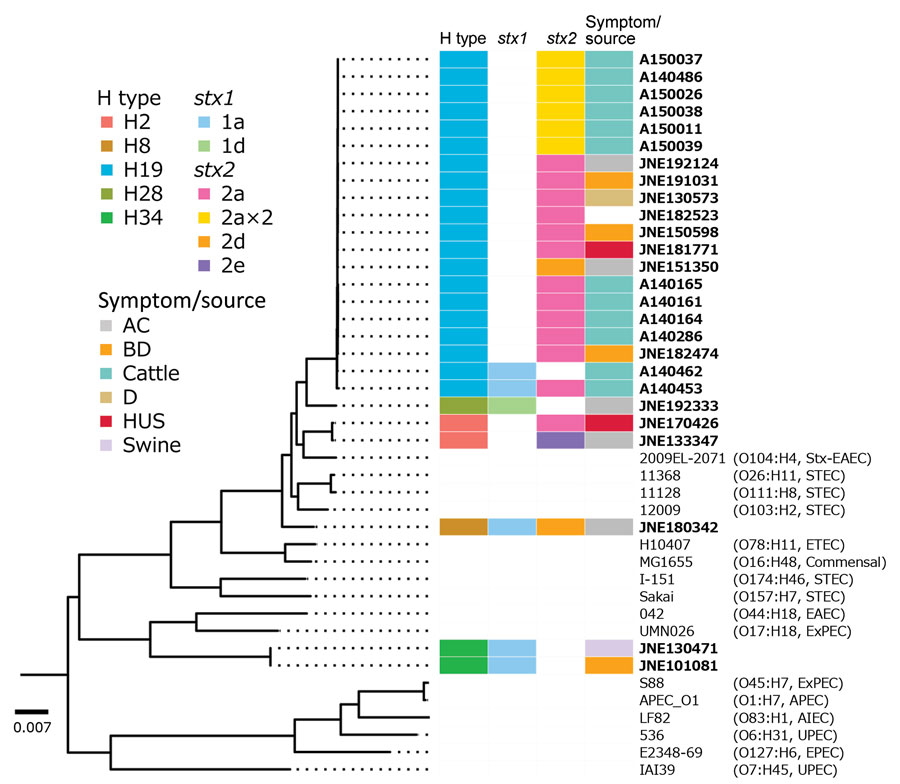Whole-Genome Sequencing of Shiga Toxin–Producing Escherichia coli OX18 from a Fatal Hemolytic Uremic Syndrome Case
Kenichi Lee

, Atsushi Iguchi, Kazuhiro Uda, Sohshi Matsumura, Isao Miyairi, Kenji Ishikura, Makoto Ohnishi, Junji Seto, Kanako Ishikawa, Noriko Konishi, Hiromi Obata, Ichiro Furukawa, Hiromi Nagaoka, Hirotaka Morinushi, Natsuki Hama, Ryohei Nomoto, Hiroshi Nakajima, Hideaki Kariya, Mitsuhiro Hamasaki, and Sunao Iyoda
Author affiliations: National Institute of Infectious Diseases, Tokyo, Japan (K. Lee, M. Ohnishi, S. Iyoda); University of Miyazaki, Miyazaki, Japan (A. Iguchi); National Center for Child Health and Development, Tokyo (K. Uda, S. Matsumura, I. Miyairi, K. Ishikura); Tokyo Metropolitan Children’s Medical Center, Tokyo (K. Uda); Kanagawa Children’s Medical Center, Kanagawa, Japan (S. Matsumura); Kitasato University School of Medicine, Tokyo (K. Ishikura); Yamagata Prefectural Institute of Public Health, Yamagata, Japan (J. Seto); Ibaraki Prefectural Institute of Public Health, Ibaraki, Japan (K. Ishikawa); Tokyo Metropolitan Institute of Public Health, Tokyo (N. Konishi, H. Obata); Kanagawa Prefectural Institute of Public Health, Kanagawa (I. Furukawa); Shizuoka Institute of Environment and Hygiene, Shizuoka, Japan (H. Nagaoka, H. Morinushi); Kobe Institute of Health, Hyogo, Japan (N. Hama, R. Nomoto); Okayama Prefectural Institute for Environmental Science and Public Health, Okayama, Japan (H. Nakajima, H. Kariya); Fukuoka Institute of Health and Environmental Sciences, Fukuoka, Japan (M. Hamasaki)
Main Article
Figure

Figure. Maximum-likelihood phylogeny of STEC OX18 from a patient in Japan and other Escherichia coli strains. Isolate identifications of STEC OX18 are shown in bold. Colored boxes indicate collection countries, stx profiles, and symptoms of human carrier or source of the STEC OX18 isolates, as shown in the keys. Serotype and pathotype information of non-OX18 E. coli strains are shown in parentheses. The tree was rooted by E. fergusonii ATCC35469. AC, asymptomatic carrier; BD, bloody diarrhea; D, diarrhea; HUS, hemolytic uremic syndrome; STEC, Shiga toxin–producing E. coli; Stx, Shiga toxin. APEC, avian pathogenic E. coli; AIEC, adherent/invasive E. coli; EAEC, enteroaggregative E. coli; EPEC, enteropathogenic E.coli; ExPEC, extraintestinal pathogenic E. coli; UPEC, uropathogenic E. coli. Scale bar indicates number of substitutions per site.
Main Article
Page created: February 21, 2021
Page updated: April 21, 2021
Page reviewed: April 21, 2021
The conclusions, findings, and opinions expressed by authors contributing to this journal do not necessarily reflect the official position of the U.S. Department of Health and Human Services, the Public Health Service, the Centers for Disease Control and Prevention, or the authors' affiliated institutions. Use of trade names is for identification only and does not imply endorsement by any of the groups named above.
